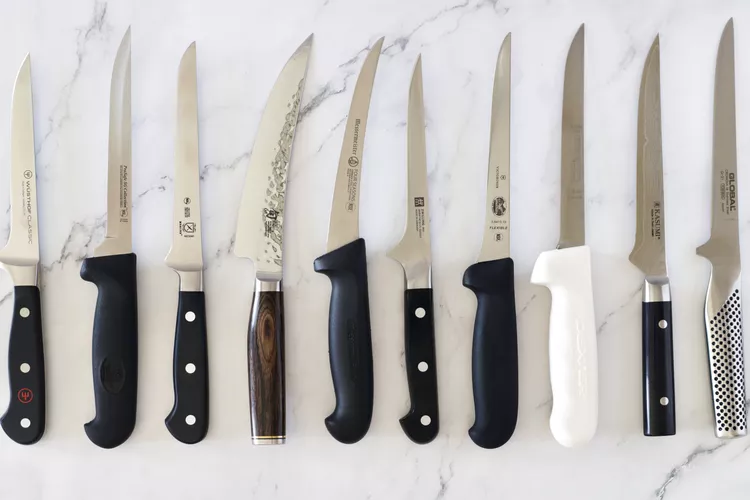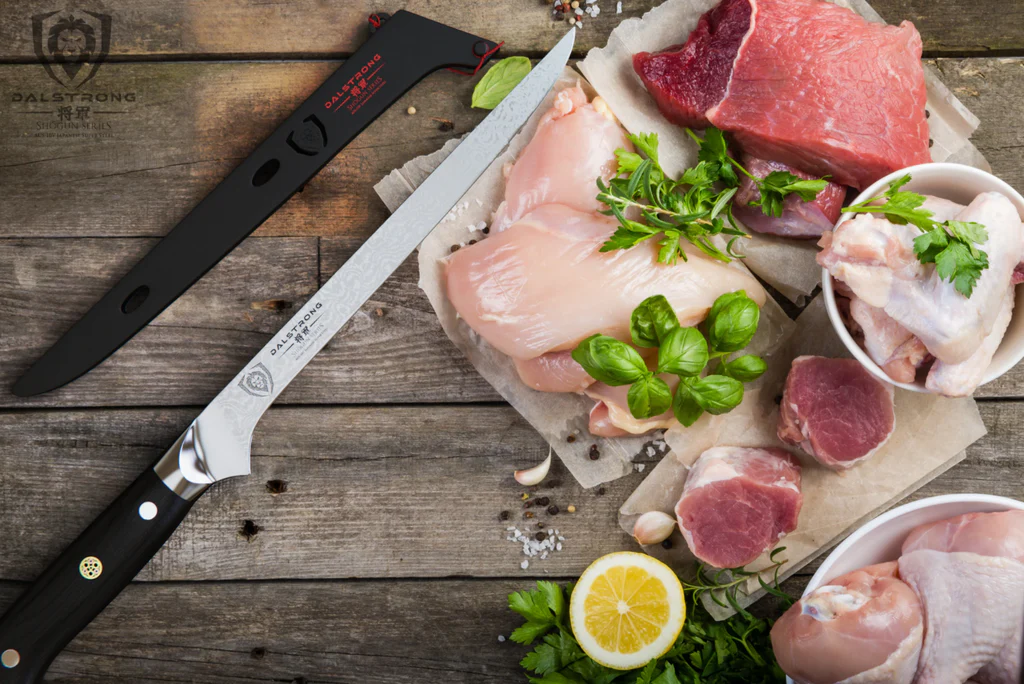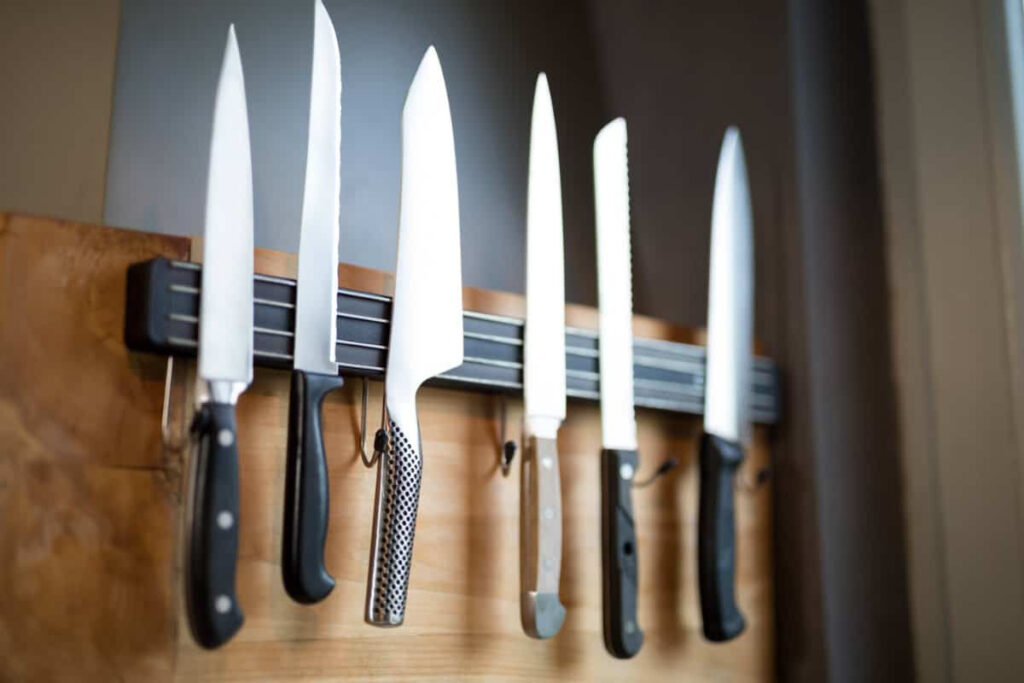Last updated on January 11th, 2024 at 08:08 am
The correct tools can help chefs achieve precision and efficiency. Boning knives are essential for chefs and home cooks. What is a boning knife and why is it useful in the kitchen?
This detailed tutorial will explore this multifunctional knife’s characteristics, uses, and benefits. This article will teach you why a boning knife is a kitchen must, whether you’re a pro or a novice.
What Is a Boning Knife?
Boning Knife Definition and Use
Boning knives are designed for delicately removing bones from meat, poultry, and fish. Butchers, chefs, and home cooks use it to separate flesh from bone.
A boning knife’s small, flexible blade lets you manoeuvre around bones, joints, and other difficult connective tissues with precision, minimising waste and maximising yield.
Boning Knife Anatomy
Boning knives have a blade, handle, and tang. The blade, usually composed of high-quality stainless steel, is extremely important. Long, slim, and pointed, it can manoeuvre around bones and joints.
Wood, plastic, or rubber handles provide a firm, ergonomic grip. The tang, which extends into the handle, gives the knife support and balance.
Boning Knives Types

Boning knives have several purposes. Boning knives are either stiff, flexible, or semi-flexible.
Stiff Boning Knife: For cutting dense meat or poultry, this boning knife features a firm blade. Stability and control allow for bigger cuts.
Flexible Boning Knife: A flexible boning knife’s blade is more bendable and precise. It works well for deboning fish and delicate meat.
Semi-Flexible Boning Knife: A semi-flexible boning knife balances rigidity with flexibility. It debones birds and fillets fish.
Boning Knife Benefits

Precise Control
Boning knives offer precision and control. The small, sharp blade makes precise cuts close to the bone, minimising waste and maximising meat output. A boning knife provides professional-level precision for reducing fat, removing bones, or separating delicate fillets.
Culinary versatility
A boning knife can do more than just bone meat. Filleting fish, skinning poultry, and removing silverskin are easy with its precision and manoeuvrability. You can easily cut and trim using a boning knife in your kitchen.
Improved Safety
Boning knives are designed for safety. The narrow blade reduces slips and cuts, letting you work confidently and effectively. Even with slick or oily ingredients, many boning knives have ergonomic handles with non-slip grips. A boning knife improves your cooking and kitchen safety.
Choosing the Right Boning Knife

Consider blade material, flexibility, and grip design when choosing a boning knife. Detailing these factors:
Blade Construction
Boning knives function and last based on blade quality and composition. Durability, corrosion resistance, and maintenance make high-carbon stainless steel a popular choice.
It retains edges and can tolerate kitchen abuse. Look for high-quality boning knives that balance sharpness, strength, and durability.
Flexible Blade Length
Boning knives are versatile due to blade flexibility. Flexible blades make bone and joint navigation easier. If you mostly chop large chunks of meat or poultry, you may want a stiffer blade for force and stability. Choose a flexible boning knife for your most often jobs.
Another factor is blade length. 5–7-inch boning knives are typical. A shorter blade is better for intricate work, whereas a longer blade cuts larger meat faster and more efficiently. Choose a blade length that meets your cooking needs.
Ergonomic Handles
Boning knife handles affect comfort and control. Find a handle that fits your hand and grips well even when wet or greasy. Ergonomic boning knives with textured or curved handles reduce fatigue and slippage.
Also consider handle material. Wood, plastic, and rubber offer durability, grip, and attractiveness.
How to Properly Use a Boning Knife

Boning knives are most effective and safe when used properly. Boning knife usage guidelines:
Boning Poultry and Meat
Locate and cut around the bone to remove it from poultry or beef. Hold the grip firmly and gently move the narrow blade along the bone. Stay close to the bone to reduce waste and maintain meat quality. Cut carefully around the bone until it is removed.
Precision Fish Filleting
Boning knives’ flexibility and sharpness help fillet fish. Make a small incision at the fish’s head and slide the blade along the backbone, following its natural contours. Use the flexible blade to cut the fillet off the bone around the ribs. Clean, even fillets require patience and a steady touch.
Slimming Down
Boning knives also remove fat and silverskin from meat. Use the sharp edge to carefully remove undesirable fat or connective tissue. Controlled slicing preserves meat quality and shape while removing the desired portions.
Use a boning knife safely. To avoid mishaps, use a non-slip cutting board, keep your fingertips away from the blade, and cut away from yourself.
Maintaining and Caring for Your Boning Knife

Boning knives must be maintained to last and operate well. Keep your knife sharp with these tips:
Maintenance and Storage
Clean your boning knife with warm, soapy water and a soft sponge or towel after use. Avoid abrasive cleaners and scrubbers. To avoid corrosion, dry the knife before keeping. Protect the blade with a knife sheath or blade guard.
Polishing Methods
Sharpening your boning knife regularly keeps it sharp and precise. Sharpen with a stone or rod. To sharpen properly, consult the manufacturer or an expert. Honing between sharpenings keeps the blade sharp. A honing rod realigns the blade’s small teeth, keeping it sharp.
Proper Care
Handle your boning knife carefully to extend its life. Avoid using the knife on bones or frozen food, which can harm the blade. Use a separate cleaver or bone saw for such jobs. Avoid prying or cutting hard things with your boning knife.
Knife maintenance requires proper storage. A knife block, magnetic strip, or knife roll protects your boning knife and makes it easy to access. Avoid storing it in a cluttered drawer where other tools may dull or ruin it.
Boning Knife FAQs
Knife vs. fillet knife?
Boning and fillet knives both cut precisely in the kitchen, yet they differ. Boning knives are firmer and used to remove bones from meat and poultry, whereas fillet knives are flexible and used to remove fish skin and bones.
Can a boning knife do anything else?
Boning knives are versatile cooking tools. They can fillet fish, trim fat, and remove silverskin from meat.
Boning knives for different meats?
A flexible, long-bladed boning knife can handle most meat-boning chores.
Boning knife sharpening: how often?
Sharpening depends on knife use and cutting activities. Boning knives should be sharpened every few months or when their cutting performance decreases.
Can lefties use boning knives?
Yes, many boning knives have ambidextrous handles. Find knives with symmetrical handles or left-handed labels.
Boning knives—dishwasher safe?
Handwash boning knives, even if they’re dishwasher safe. Dishwashers can harm blades and handles due to harsh detergents, high temperatures, and utensil contact.
Conclusion
Chefs and home cooks who want precision and efficiency need a boning knife. A boning knife’s small, flexible blade lets you manoeuvre around bones, joints, and strong connective tissues with precision and minimal waste. Boning knives are ideal for deboning, filleting, and removing fat.
You may improve your cooking skills and get professional results by learning about boning knives, picking the perfect one, and using it properly.
